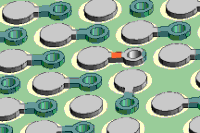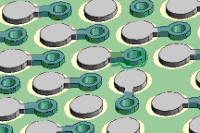Solder Mask Touch-Up At BGA Sites
|

|
|
|
Figure 1: Where mask has been peeled or broken away, it must be replaced. Loose pieces should be scraped off.
|
Solder mask has one primary purpose at a BGA site, and that is to isolate solder wetting to a specific area, e.g., the BGA pad, so that a good solder joint will be formed.
Solder mask usually isolates the pad from the conductor, or from the track leading to a via or plated hole. Sometimes the track and hole are completely masked; sometimes there is only a thin "dam" of mask between the pad area and exposed track and hole. This dam or masking is delicate and easily damaged or dislodged during rework. If it isn't repaired, the result often more rework, or rework upon rework!
Once a BGA device is removed from a site, that site must be prepared before the replacement process. Preparing usually involves removing residual solder from the BGA pads on the circuit board, typically done with a soldering iron and copper braid solder wicking material. Then the rework area is cleaned.

|
|
|
Figure 2: Replacement epoxy should be applied with a fine-needle dispenser.
|
Once cleaned, fresh solder is added to the BGA pad sites, either through dispensing of solder paste, stenciling solder paste through the use of a mini-stencil, or by pre-bumping the pads with solder. A new BGA component is finally placed at the site, and the site and BGA heated to reflow the solder and make a new connection.
If the solder mask around any of the individual BGA pads was damaged during board preparation, there's a strong chance that the new solder placed on that pad will simply flow down the track, and potentially into the plated via hole. This will often leave insufficient solder on the pad to form a new solder joint, and the result will be either an insufficient or "starved" solder joint, or an open.
There is no simple remedy. You will need to remove the new BGA component and start over. A perfectly good component may be ruined. The circuit board also risks damage through multiple thermal cycles reworking the same area. If the new component must be removed, that removal will be at least the 4th time that the site has been exposed to reflow temperatures.
Even the most careful operator can damage the solder mask during board preparation. Heating, plus the slightly abrasive action of wicking solder, or cleaning the area can damage the solder mask. That's why it is important, once the board has been cleaned, to inspect the solder masked areas of the site carefully. Where solder mask has been peeled or broken away, it must be replaced.
Loose pieces should be scraped off. (See Figure 1). Once the solder has been cleaned from the site, it is important to scrape any remaining solder from the surface of each trace, exposing the copper. The site can then be cleaned and encapsulated with replacement solder mask or epoxy. We typically use two-part epoxy instead of replacement solder mask.
Without this scraping, we've occasionally see the solder bleed underneath the epoxy, and flow down the trace to the via. This replacement epoxy should be applied with a fine needle dispenser. Sometimes, even that is too much; our operators sometimes use a thin needle dipped into the epoxy and then painting across the track to re-create the mask dam. (See Figure 2). This takes skill and a steady hand.
Following application of the mask, the circuit board must be baked, in strict accordance with the epoxy specifications to ensure a proper cure. Don't take shortcuts. Only then can new solder be applied to the BGA site, the new BGA component placed on the board, and the site reflowed.
The process of replacing solder mask at BGA sites is time-consuming, meticulous work. There is no quick or easy way around it.
Several members of the Circuit Technology Center team contributed to this feature story.
|
|
|
|
|